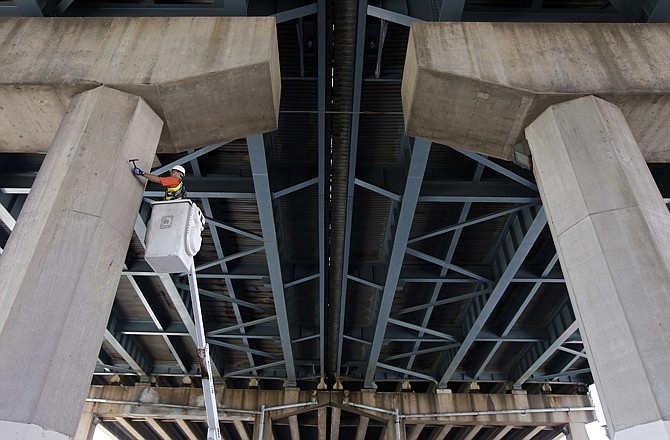WASHINGTON (AP) - There was a crack in the Washington Monument, and capstones were broken at the National Cathedral. In the District of Columbia suburbs, some people stayed in shelters because of structural concerns at their apartment buildings.
A day after the East Coast's strongest earthquake in 67 years, inspectors assessed the damage and found that most problems were minor. But the shaking raised questions about whether this part of the country, with its older architecture and inexperience with seismic activity, is prepared for a truly powerful quake.
The 5.8 magnitude quake felt from Georgia north to Canada prompted swift inspections of many structures Wednesday, including bridges and nuclear plants. An accurate damage estimate could take weeks, if not longer. And many people will not be covered by insurance.
In a small Virginia city near the epicenter, the entire downtown business district was closed. School was canceled for two weeks to give engineers time to check out cracks in several buildings.
At the 555-foot Washington Monument, crews found a 4-inch crack late Tuesday in the side of the monument's pyramidium - the section at the top of the obelisk where it begins narrowing to a point. The damage was discovered during a visual inspection by helicopter. It cannot be seen from the ground.
The monument, by far the tallest structure in the nation's capital, was to remain closed indefinitely. It has never been damaged by a natural disaster, including earthquakes in Virginia in 1897 and New York in 1944, said Bill Line, a National Park Service spokesman.
Tourists arrived at the monument Wednesday morning only to find out they couldn't get near it. A temporary fence was erected in a wide circle about 120 feet from the flags that surround its base. Walkways were blocked by metal barriers manned by security guards.
"Is it really closed?" a man asked the clerk at the site's bookstore.
"It's really closed," said the clerk, Erin Nolan. Advance tickets were available for purchase, but she cautioned against buying them because it's not clear when the monument will open.
"This is pretty much all I'm going to be doing today," Nolan said.
Tuesday's quake was centered about 40 miles northwest of Richmond, 90 miles south of Washington and 3.7 miles underground. In the nearby town of Mineral, Va., Michael Leman knew his Main Street Plumbing & Electrical Supply business would need - at best - serious and expensive repairs.
At worst, it could be condemned. The facade had become detached from the rest of the building, and daylight was visible through a 4- to 6-inch gap that opened between the front wall and ceiling.
"We're definitely going to open back up," Leman said. "I've got people's jobs to look out for."
Leman said he is insured, but some property owners might not be so lucky.
The Insurance Information Institute said earthquakes are not covered under standard U.S. homeowners or business insurance policies, although supplemental coverage is usually available.
The institute says coverage for other damage that may result from earthquakes, such as fire and water damage from burst gas or water pipes, is provided by standard homeowners and business insurance policies in most states. Cars and other vehicles with comprehensive insurance would also be protected.
The U.S. Geological Survey classified the quake as Alert Level Orange, the second-most serious category on its four-level scale. Earthquakes in that range lead to estimated losses between $100 million and $1 billion.
In Culpeper, Va., about 35 miles from the epicenter, walls had buckled at the old sanctuary at St. Stephen's Episcopal Church, which was constructed in 1821 and drew worshippers including Confederate Gens. Robert E. Lee and J.E.B. Stuart. Heavy stone ornaments atop a pillar at the gate were shaken to the ground. A chimney from the old Culpeper Baptist Church built in 1894 also tumbled down.
At the Washington National Cathedral, spokesman Richard Weinberg said the building's overall structure remains sound and damage was limited to "decorative elements."
Massive stones atop three of the four spires on the building's central tower broke off, crashing onto the roof. At least one of the spires is teetering badly, and cracks have appeared in some flying buttresses.
Repairs were expected to cost millions of dollars - an expense not covered by insurance.
"Every single portion of the exterior is carved by hand, so everything broken off is a piece of art," Weinberg said. "It's not just the labor, but the artistry of replicating what was once there."
The building will remain closed as a precaution, forcing officials to seek a new site for services to dedicate the memorial honoring Rev. Martin Luther King Jr.
Other major cities along the East Coast that felt the shaking tried to gauge the risk from another quake.
A few hours after briefly evacuating New York City Hall, Mayor Michael Bloomberg said the city's newer buildings could withstand a more serious earthquake. But, he added, questions remain about the older buildings that are common in a metropolis founded hundreds of years ago.
"We think that the design standards of today are sufficient against any eventuality," he said. But "there are questions always about some very old buildings. ... Fortunately those tend to be low buildings, so there's not great danger."
An earthquake similar to the one in Virginia could do billions of dollars of damage if it were centered in New York, said Barbara Nadel, an architect who specializes in securing buildings against natural disasters and terrorism.

